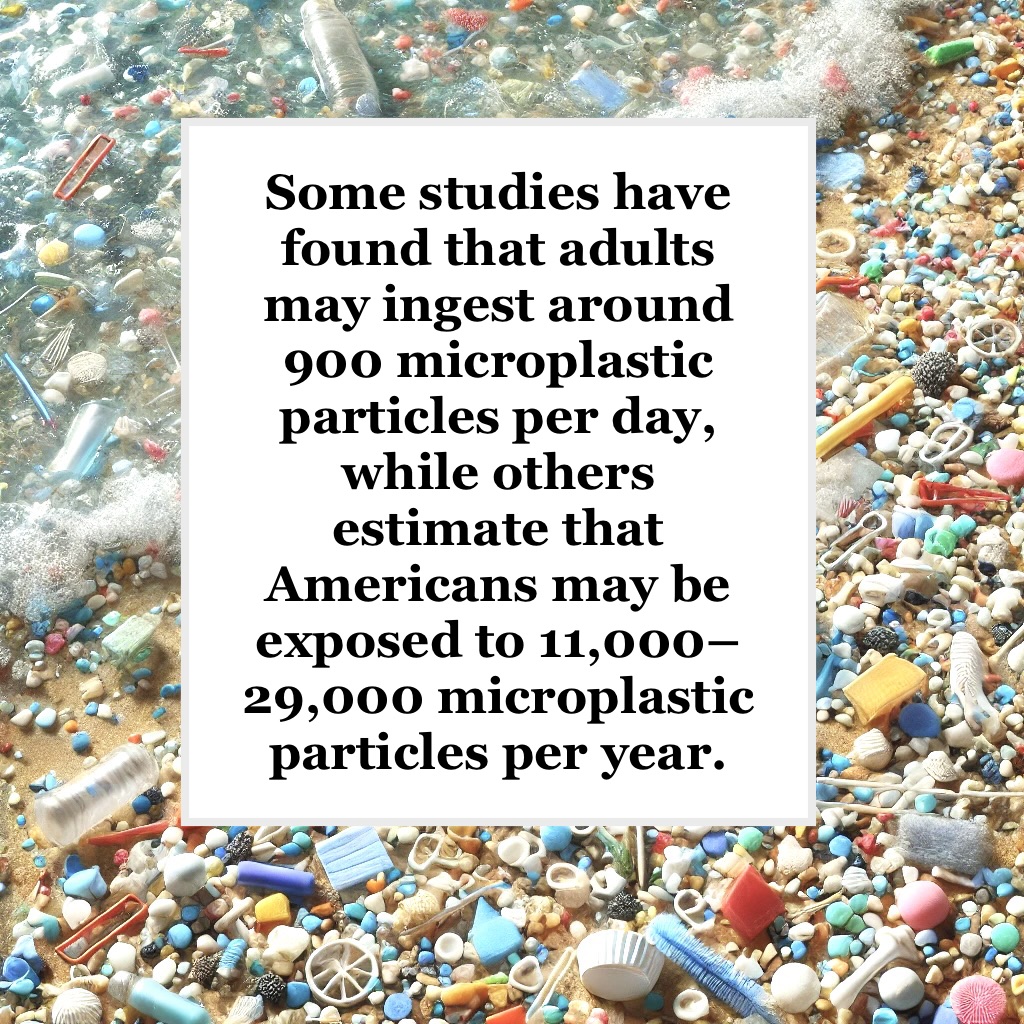Microplastics have been found in a variety of environments, from the deepest oceans to the highest mountains, and even in human food and water supplies. They pose significant risks to wildlife and ecosystems, as well as potential health risks to humans through ingestion and inhalation. There is an urgent need for global action to mitigate the impact of microplastics on the environment and human health do to their pervasive nature. Here are some interesting facts about Microplastics
- History of Microplastics:
- Microplastics have been around since the mid-20th century, coinciding with the mass production and widespread use of plastics. However, awareness of their environmental impact has grown significantly in recent decades.
- Early Years: The production of plastics began to surge in the 1950s. Over time, plastic waste began to accumulate, and the breakdown of larger plastic items led to the formation of microplastics.
- Scientific Recognition: The term “microplastics” was first coined in 2004 by marine biologist Richard Thompson, who highlighted their prevalence in marine environments .
- Increased Awareness: Research into microplastics has expanded rapidly since the early 2000s, uncovering their widespread presence and potential health impacts.
- Microplastics have been around since the mid-20th century, coinciding with the mass production and widespread use of plastics. However, awareness of their environmental impact has grown significantly in recent decades.
- Ubiquity in the Environment:
- Microplastics are found in almost every environment on Earth, including remote locations like the Arctic and deep-sea trenches.
- They are present in the air we breathe, the water we drink, and the food we eat.
- Types and Sources:
- Microplastics are small plastic particles less than 5 millimeters in size. They originate from various sources, broadly categorized into primary and secondary microplastics. Microplastics are classified into two types: primary microplastics and secondary microplastics.
- Primary Microplastics: These are intentionally manufactured small plastic particles.
- Microbeads: Used in personal care products like exfoliants, toothpaste, and cosmetics.
- Pre-production Pellets (Nurdles): Small plastic pellets used as raw material in plastic manufacturing.
- Synthetic Fibers: Shed from synthetic textiles during washing, such as polyester, nylon, and acrylic.
- Secondary Microplastics: These are formed from the breakdown of larger plastic items.
- Plastic Packaging: Bags, bottles, and other packaging materials degrade over time into smaller particles.
- Tire Wear: Particles produced from the abrasion of tires against roads.
- Paints: Flaking from ship paints, road markings, and household paints.
- Consumer Products: Degradation of products like plastic toys, containers, and household items.
- Primary Microplastics: These are intentionally manufactured small plastic particles.
- Common sources of microplastics include synthetic clothing fibers, tire wear particles, and plastic packaging.
- Microplastics are small plastic particles less than 5 millimeters in size. They originate from various sources, broadly categorized into primary and secondary microplastics. Microplastics are classified into two types: primary microplastics and secondary microplastics.
- Health Impact:
- Microplastics can carry harmful chemicals and pollutants. When ingested by humans or animals, these particles can potentially cause health issues.
- Studies are ongoing to understand the full impact on human health, but concerns include inflammation and toxicity due to the chemicals attached to microplastics.
- Recent studies have highlighted the concerning amount of microplastics humans might be ingesting. According to research by the World Wide Fund for Nature (WWF) and the University of Newcastle, Australia, the average person could be ingesting around 5 grams of plastic every week.
- To break this down monthly:
- Weekly Ingestion: 5 grams
- Monthly Ingestion: 5 grams/week * 4 weeks/month = 20 grams/month
- Thus, humans might be ingesting approximately 20 grams of plastic every month. This estimation includes plastic particles found in food, water, and even the air we breathe. Some estimates range from 0.1–5 grams per week. Some studies have found that adults may ingest around 900 microplastic particles per day, while others estimate that Americans may be exposed to 11,000–29,000 microplastic particles per year.
- To break this down monthly:
- Recent studies have highlighted the concerning amount of microplastics humans might be ingesting. According to research by the World Wide Fund for Nature (WWF) and the University of Newcastle, Australia, the average person could be ingesting around 5 grams of plastic every week.
- Marine Life and Food Chain:
- Marine organisms, from plankton to whales, ingest microplastics, which can lead to physical harm, reduced feeding, and reproductive issues.
- Microplastics can enter the food chain, accumulating in fish and shellfish that are consumed by humans.
- Wastewater Treatment:
- Wastewater treatment plants are a significant source of microplastics in the environment. They capture large amounts of microplastics, but not all are removed, and many end up in rivers and oceans. One of the best and easiest ways to prevent microplastics and waste in our wastewater is to stop using wipes and use a bidet instead.
- Regulation and Reduction Efforts:
- Some countries have banned or restricted the use of microbeads in cosmetics and personal care products. It is best to use natural beauty products instead.
- Efforts to reduce plastic waste, improve recycling, and develop biodegradable alternatives are crucial in addressing the issue of microplastics.
U.S. Efforts to Prevent Microplastics
The United States has implemented several measures to address the issue of microplastics, focusing on both regulatory actions and public awareness campaigns. Here are some key initiatives and regulations:
1. Microbead-Free Waters Act of 2015
- Overview: This federal law prohibits the manufacture and sale of rinse-off cosmetics containing plastic microbeads.
- Impact: The law, effective from July 1, 2017, has significantly reduced the number of microbeads entering waterways.
- Source: FDA – Microbead-Free Waters Act
2. Research and Monitoring
- NOAA Marine Debris Program: The National Oceanic and Atmospheric Administration (NOAA) conducts research on marine debris, including microplastics, and develops strategies to mitigate their impact.
- EPA Initiatives: The Environmental Protection Agency (EPA) supports research on microplastic pollution and its effects on human health and the environment.
- Source: NOAA Marine Debris Program
3. State-Level Bans and Initiatives
Several states have taken additional measures to combat microplastic pollution:
- California: California has enacted laws to reduce microplastic pollution, including a ban on microplastics in personal care products and measures to reduce plastic waste overall.
- New York: New York State has implemented similar bans on microbeads and is active in broader plastic reduction efforts.
- Massachusetts: The Massachusetts Senate has passed the Plastics Reduction Act, which calls for numerous measures including banning carry-out plastic bags and preventing restaurants from automatically giving out plastic utensils and straws. It also calls for creating a commission to explore EPR for packaging and other items. Also, Massachusetts is the first state to ban the purchase of single-use plastic bottles by state agencies.
4. Public Awareness and Education
- NGO and Community Efforts: Non-governmental organizations (NGOs) such as the Surfrider Foundation and 5 Gyres Institute engage in public education campaigns to raise awareness about microplastic pollution and promote sustainable practices.
- Educational Programs: Schools and community groups conduct programs to educate the public about the environmental impact of microplastics and how to reduce plastic waste.
5. Innovation and Industry Initiatives
- Biodegradable Alternatives: Companies and research institutions are developing biodegradable alternatives to traditional plastics to reduce the generation of microplastics.
- Sustainable Product Design: Some companies are redesigning products to minimize plastic use and enhance recyclability.
6. Policy and Legislation Proposals
- Break Free From Plastic Pollution Act: This proposed federal legislation aims to reduce plastic production and improve waste management, addressing the root causes of plastic pollution.
- Extended Producer Responsibility (EPR): Policies that hold producers responsible for the entire lifecycle of their products, including post-consumer waste, are being considered to reduce plastic waste.
Challenges and Future Directions
While these measures represent significant steps toward reducing microplastic pollution, ongoing efforts and increased cooperation between government, industry, and the public are essential to further address this issue. Enhanced regulation, innovative solutions, and continuous education will be crucial in mitigating the impact of microplastics.
Individual Efforts to Reduce Plastic Waste:
Each choice individuals make matters. We can choose to make more eco-conscious decisions to help the environment, our health, and even save money while doing it. Please read this article about Green Ways to Save Green: Eco-Friendly Ways to Save Money
Green Ways to Save Green: Eco-Friendly Ways to Save Money
For more simple ways to help the environment, please read:
Green Cleaning
Saving with a Water Bottle
Plastic-Free Laundry
Less Waste with a Bidet!
Sources
- National Geographic – Microplastics in the Arctic
- Smithsonian Magazine – Microplastics Found in the Deep Sea
- World Health Organization – Microplastics in Drinking Water
- Environmental Science & Technology – Health Risks of Microplastics
- National Ocean Service – Marine Debris
- Scientific American – Microplastics in Seafood
- Environmental Research – Microplastics and Human Health
- U.S. Environmental Protection Agency – Reducing Microplastics
- FDA – Microbead-Free Waters Act
- NOAA Marine Debris Program
- California State Water Resources Control Board
- Surfrider Foundation
- 5 Gyres Institute

DIFER.ORG is committed to reducing waste and supports efforts to help our environment






I just wanted to say that your article is remarkable. The clarity and depth of your knowledge are truly refreshing. May I subscribe to keep up with your future posts? Keep up the fantastic work!
This was an interesting read that was very informative. I hadn’t realized how many problems microplastic pose.